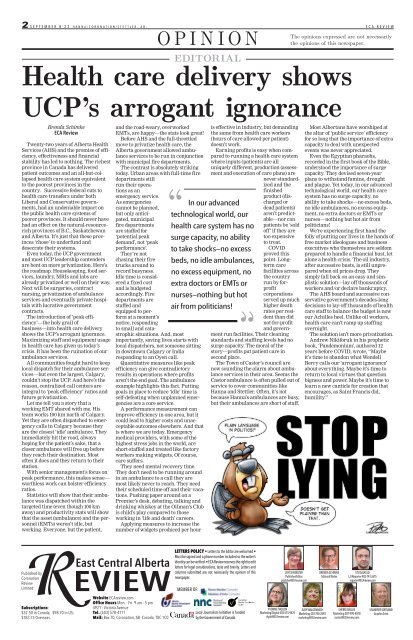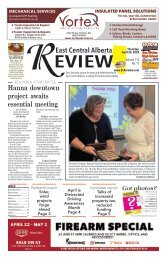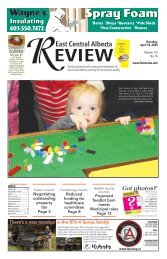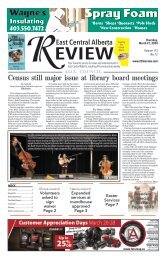ECA Review - 2022-09-08
ECA Review - 2022-09-08
ECA Review - 2022-09-08
You also want an ePaper? Increase the reach of your titles
YUMPU automatically turns print PDFs into web optimized ePapers that Google loves.
2 September 8'22 HANNA/CORONATION/STETTLER, AB. <strong>ECA</strong> REVIEW<br />
OPINION<br />
The opinions expressed are not necessarily<br />
the opinions of this newspaper.<br />
<br />
EDITORIAL<br />
Health care delivery shows<br />
UCP’s arrogant ignorance<br />
Brenda Schimke<br />
<strong>ECA</strong> <strong>Review</strong><br />
Twenty-two years of Alberta Health<br />
Services (AHS) and the promise of efficiency,<br />
effectiveness and financial<br />
stability has led to nothing. The richest<br />
province in Canada has delivered<br />
patient outcomes and an all-but-collapsed<br />
health care system equivalent<br />
to the poorest provinces in the<br />
country. Successive federal cuts to<br />
health care transfers under both<br />
Liberal and Conservative governments,<br />
had an undeniable impact on<br />
the public health care systems of<br />
poorer provinces. It should never have<br />
had an effect on the natural-resourcerich<br />
provinces of B.C., Saskatchewan<br />
and Alberta. It’s just that these provinces<br />
‘chose’ to underfund and<br />
desecrate their systems.<br />
Even today, the UCP government<br />
and most UCP leadership contenders<br />
are bent on more privatization. Here’s<br />
the roadmap. Housekeeping, food services,<br />
laundry, MRIs and labs are<br />
already privatized or well on their way.<br />
Next will be surgeries, contract<br />
nursing, privatization of ambulance<br />
services and eventually private hospitals<br />
with lucrative government<br />
contracts.<br />
The introduction of ‘peak efficiency’—the<br />
holy grail of<br />
business—into health care delivery<br />
shows the UCP’s arrogant ignorance.<br />
Maximizing staff and equipment usage<br />
in health care has given us today’s<br />
crisis. It has been the ruination of our<br />
ambulance services.<br />
All communities fought hard to keep<br />
local dispatch for their ambulance services—but<br />
even the largest, Calgary,<br />
couldn’t stop the UCP. And here’s the<br />
reason, centralized call centers are<br />
integral to ‘peak efficiency’ ratios and<br />
future privatization.<br />
Let me tell you a story that a<br />
working EMT shared with me. His<br />
team works 100 km north of Calgary.<br />
Yet they are often dispatched to emergency<br />
calls in Calgary because they<br />
are the closest ‘idle’ ambulance. They<br />
immediately hit the road, always<br />
hoping for the patient’s sake, that a<br />
closer ambulance will free up before<br />
they reach their destination. Most<br />
often it does and they return to their<br />
station.<br />
With senior management’s focus on<br />
peak performance, this makes sense—<br />
worthless work can bolster efficiency<br />
ratios.<br />
Statistics will show that their ambulance<br />
was dispatched within the<br />
targeted time (even though 100 km<br />
away) and productivity stats will show<br />
that the asset (ambulance) and the personnel<br />
(EMTs) weren’t idle, but<br />
working. Everyone, but the patient,<br />
and the road-weary, overworked<br />
EMTs, are happy—the stats look great!<br />
Before AHS and the full-throttled<br />
move to privatize health care, the<br />
Alberta government allowed ambulance<br />
services to be run in conjunction<br />
with municipal fire departments.<br />
The contrast is absolutely striking<br />
today. Urban areas with full-time fire<br />
departments still<br />
run their operations<br />
as an<br />
“<br />
emergency service.<br />
As emergencies<br />
cannot be planned,<br />
but only anticipated,<br />
municipal<br />
fire departments<br />
are staffed for<br />
‘potential peak<br />
demand’, not ‘peak<br />
performance’.<br />
They’re not<br />
chasing their fire<br />
trucks around to<br />
record busyness.<br />
Idle time is considered<br />
a fixed cost<br />
and is budgeted<br />
accordingly. Fire<br />
departments are<br />
staffed and<br />
equipped to perform<br />
at a moment’s<br />
notice, responding<br />
to small and catastrophic<br />
situations. And, most<br />
importantly, saving lives starts with<br />
local dispatchers, not someone sitting<br />
in downtown Calgary or India<br />
responding to an Oyen call.<br />
Quantitative measures like peak<br />
efficiency can give contradictory<br />
results in operations where profits<br />
aren’t the end goal. The ambulance<br />
example highlights this fact. Putting<br />
goals in place to reduce ‘idle’ time is<br />
self-defeating when unplanned emergencies<br />
are a core service.<br />
A performance measurement can<br />
improve efficiency in one area, but it<br />
could lead to higher costs and unacceptable<br />
outcomes elsewhere. And that<br />
is where we are today. Emergency<br />
medical providers, with some of the<br />
highest stress jobs in the world, are<br />
short-staffed and treated like factory<br />
workers making widgets. Of course,<br />
care suffers.<br />
They need mental recovery time.<br />
They don’t need to be running around<br />
in an ambulance to a call they are<br />
most likely never to reach. They need<br />
their scheduled time off and their vacations.<br />
Pushing paper around on a<br />
Premier’s desk, debating, talking and<br />
drinking whiskey at the Oilman’s Club<br />
is child’s play compared to those<br />
working in ‘life and death’ careers.<br />
Applying measures to increase the<br />
number of widgets produced per hour<br />
In our advanced<br />
technological world, our<br />
health care system has no<br />
surge capacity, no ability<br />
to take shocks—no excess<br />
beds, no idle ambulances,<br />
no excess equipment, no<br />
extra doctors or EMTs or<br />
nurses—nothing but hot<br />
air from politicians!<br />
is effective in industry, but demanding<br />
the same from health care workers<br />
(hours of care allowed per patient)<br />
doesn’t work.<br />
Earning profits is easy when compared<br />
to running a health care system<br />
where inputs (patients) are all<br />
uniquely different, production (assessment<br />
and execution of care plans) are<br />
never standardized<br />
and the<br />
finished<br />
product (discharged<br />
or<br />
dead patients)<br />
aren’t predictable—nor<br />
can<br />
patients be ‘sold<br />
off’ if they are<br />
too expensive<br />
to treat.<br />
COVID<br />
proved this<br />
point. Longterm<br />
care<br />
facilities across<br />
the country<br />
run by forprofit<br />
corporations<br />
served up much<br />
higher death<br />
rates per resident<br />
than did<br />
not-for-profit<br />
and government<br />
run facilities. Their cleaning<br />
standards and staffing levels had no<br />
surge capacity. The moral of the<br />
story—profits put patient care in<br />
second place.<br />
The Town of Castor’s council are<br />
now sounding the alarm about ambulance<br />
services in their area. Seems the<br />
Castor ambulance is often pulled out of<br />
service to cover communities like<br />
Hanna and Stettler. Often, it’s not<br />
because Hanna’s ambulances are busy,<br />
but their ambulances are short of staff.<br />
“<br />
Most Albertans have worshiped at<br />
the altar of ‘public service’ efficiency<br />
for so long that the importance of extra<br />
capacity to deal with unexpected<br />
events was never appreciated.<br />
Even the Egyptian pharaohs,<br />
recorded in the first book of the Bible,<br />
understood the importance of surge<br />
capacity. They devised seven-year<br />
plans to withstand famine, drought<br />
and plague. Yet today, in our advanced<br />
technological world, our health care<br />
system has no surge capacity, no<br />
ability to take shocks—no excess beds,<br />
no idle ambulances, no excess equipment,<br />
no extra doctors or EMTs or<br />
nurses—nothing but hot air from<br />
politicians!<br />
We’re experiencing first hand the<br />
folly of putting our lives in the hands of<br />
free market ideologues and business<br />
executives who themselves are seldom<br />
prepared to handle a financial bust, let<br />
alone a health crisis. The oil industry,<br />
after successive busts, is still unprepared<br />
when oil prices drop. They<br />
simply fall back on an easy and simplistic<br />
solution—lay off thousands of<br />
workers and/or declare bankruptcy.<br />
The AHS board and successive conservative<br />
government’s decades-long<br />
decisions to lay-off thousands of health<br />
care staff to balance the budget is now<br />
our Achilles heel. Unlike oil workers,<br />
health care can’t ramp up staffing<br />
overnight.<br />
The solution isn’t more privatization.<br />
Andrew Nikiforuk in his prophetic<br />
book, ‘Pandemonium’, authored 12<br />
years before COVID, wrote, “Maybe<br />
it’s time to abandon what Wendell<br />
Berry calls our ‘arrogant ignorance’<br />
about everything. Maybe it’s time to<br />
return to local virtues that question<br />
bigness and power. Maybe it’s time to<br />
learn a new canticle for creation that<br />
encourages, as Saint Francis did,<br />
humility.”<br />
R<br />
R<br />
R<br />
R<br />
R<br />
Published by<br />
Coronation<br />
<strong>Review</strong><br />
Limited<br />
Subscriptions:<br />
$52.50 in Canada; $98.70 in US;<br />
$183.75 Overseas.<br />
72 pt<br />
East Central Alberta<br />
EVIEW<br />
60 pt<br />
48 pt<br />
36 pt<br />
Website <strong>ECA</strong>review.com<br />
Office Hours Mon. - Fri. 9 am - 5 pm<br />
R<br />
30 pt<br />
4921 - Victoria Avenue<br />
Tel. (403) 578-4111<br />
R<br />
24 pt<br />
Mail: Box 70, Coronation, AB Canada, T0C 1C0<br />
LETTERS POLICY • Letters to the Editor are welcomed •<br />
Must be signed and a phone number included so the writer’s<br />
identity can be verified. • <strong>ECA</strong> <strong>Review</strong> reserves the right to edit<br />
letters for legal considerations, taste and brevity. Letters and<br />
columns submitted are not necessarily the opinion of this<br />
newspaper.<br />
MEMBER OF:<br />
Local Journalism Initiative is funded<br />
by the Government of Canada.<br />
JOYCE WEBSTER<br />
Publisher/Editor<br />
publisher@<strong>ECA</strong>review.com<br />
YVONNE THULIEN<br />
Marketing/Digital 403-575-9474<br />
digital@<strong>ECA</strong>review.com<br />
JUDY WALGENBACH<br />
Marketing 403-740-2492<br />
marketing@<strong>ECA</strong>review.com<br />
BRENDA SCHIMKE<br />
Editorial Writer<br />
SHEREE BAILLIE<br />
Marketing 587-990-4818<br />
contact@<strong>ECA</strong>review.com<br />
STU SALKELD<br />
LJI Reporter 403-741-2615<br />
reporter@<strong>ECA</strong>review.com<br />
LISA MYERS-SORTLAND<br />
Graphic Artist<br />
R<br />
18 pt


















